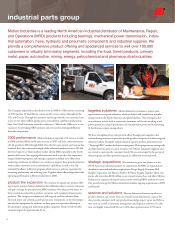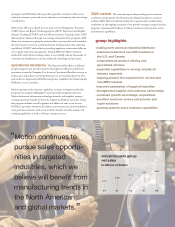Napa Auto Parts 2008 Annual Report Download - page 20
Download and view the complete annual report
Please find page 20 of the 2008 Napa Auto Parts annual report below. You can navigate through the pages in the report by either clicking on the pages listed below, or by using the keyword search tool below to find specific information within the annual report.management’s discussion and analysis of nancial condition and results of operations (cont.)
2008
In 2008, 2007, and 2006, each of our four business segments experi-
enced vendor price increases, and by working with our customers we
were able to pass most of these along to them.
Operating Expenses
Selling, administrative and other expenses (“SG&A”) increased
slightly to $2.4 billion in 2008, representing 21.4% of net sales and
up from 21.0% of net sales in 2007. SG&A expenses as a percentage
of net sales increased from the prior year despite the benefits of our
ongoing cost control initiatives, which, for 2008, were offset by the
lower level of sales growth relative to the prior year. Our cost man-
agement initiatives emphasize continuous improvement programs
designed to optimize our utilization of people and systems which
is especially important in a difficult economy. During 2008, the
Company reduced its workforce by approximately 5% in an effort to
properly adjust our costs to lower sales volumes. We also have initia-
tives in place to further reduce our expenses, including additional
reductions associated with personnel costs as well as planned savings
in areas such as fleet management and fuel and energy consumption.
Our management teams are focused on the ongoing assessment of
the appropriate cost structure in our businesses and the need for
additional cost reductions, while maintaining our high standards for
excellent customer service.
Depreciation and amortization expense in 2008 was $89 million,
relatively consistent with 2007. e provision for doubtful accounts
was $24 million in 2008, up from a $14 million bad debt expense
in 2007. Our bad debt expense reflects an increase in uncollectible
accounts receivables in 2008 and is likely directly correlated to the
effects of the difficult economic climate, which has pressured certain
of our customers. We believe the Company is adequately reserved
for bad debts at December 31, 2008.
In 2007, SG&A increased slightly to $2.3 billion, or 21.0% of net
sales, which was improved from 2006 when SG&A as a percent of
net sales was 21.2%. Depreciation and amortization expense in 2007
was $88 million, up 19% from 2006, reflecting our increased level of
capital spending in 2006 and 2007 relative to the previous few years.
e provision for doubtful accounts was $14 million in 2007, down
from a $16 million bad debt expense in 2006.
Non-Operating Expenses and Income
Non-operating expenses consist primarily of interest. Interest
expense was relatively steady over the last three years, at $32 million,
$31 million and $32 million in 2008, 2007 and 2006, respectively.
In “Other”, interest income net of minority interests decreased in
2008 from the prior two years due to the effects of lower interest
rates and reduced cash balances on which interest income is earned.
Income Before Income Taxes
Income before income taxes was $768 million in 2008, a decrease
of 5.9% from $817 million in 2007. As a percentage of net sales,
income before income taxes was 7.0% in 2008, reflecting a decrease
from 7.5% in 2007. In 2007, income before income taxes of $817
million was up 5.9% from $771 million in 2006 and as a percentage
of net sales was 7.5%, up from 7.4% in 2006.
Automotive Group
Automotive income before income taxes as a percentage of net sales,
which we refer to as operating margin, decreased to 7.2% in 2008
from 7.8% in 2007. e decline in operating margin for 2008 is
attributed to Automotive’s lower sales volume for the year, partially
offset by the benefit of cost reduction measures. Automotive’s initia-
tives to grow sales and control costs are intended to improve its
operating margin in the years ahead.
Automotive operating margins increased to 7.8% in 2007 from 7.7% in
2006. Our progress in 2007 primarily related to non-recurring costs
incurred in 2006 for certain closing and consolidation expenses at
Johnson Industries and our re-manufacturing operations.
Industrial Group
Industrial operating margins were 8.4% in 2008, which is unchanged
from the operating margin in 2007 and up from 8.3% in 2006.
After several years of ongoing operating margin improvement for
Industrial, the lower level of sales growth in 2008 offset the effective-
ness of our sales and operating initiatives. We will continue to focus
on these initiatives, however, to show progress in the years ahead.
Office Group
Operating margins in Office were 8.3% in 2008, down from 8.9% in
2007 and 9.4% in 2006. e prevailing weakness in the office prod-
ucts industry that began in the latter part of 2006 continued to pres-
sure the operating margins at Office in 2007 and 2008, and we will
likely face more moderation in demand over the next several quarters.
As we work to better align our costs to revenues, our near term sales
initiatives at Office are focused on capturing additional marketshare.
Electrical Group
Operating margins in Electrical increased to 7.9% in 2008, up from
7.0% in 2007 and 5.5% in 2006. Our progress in 2008 represents
the fifth consecutive year of operating margin improvement for
Electrical. e manufacturing sector of the economy was strong
over most of this five-year period, which helped drive Electrical’s
progress. Assuming a weak manufacturing sector for the near term,
Electrical will rely more on its sales and cost initiatives than the
strength of the manufacturing sector for continued progress.
Income Taxes
e effective income tax rate increased to 38.1% in 2008 from 38.0%
in 2007. e net increase from the prior year rate is mainly due to a
non-deductible expense associated with a Company retirement plan.
e 38.0% tax rate in 2007 had decreased from 38.3% in 2006. e
decrease in the effective rate in 2007 was primarily due to lower state
taxes and favorable tax rate changes in Canada.
18
























